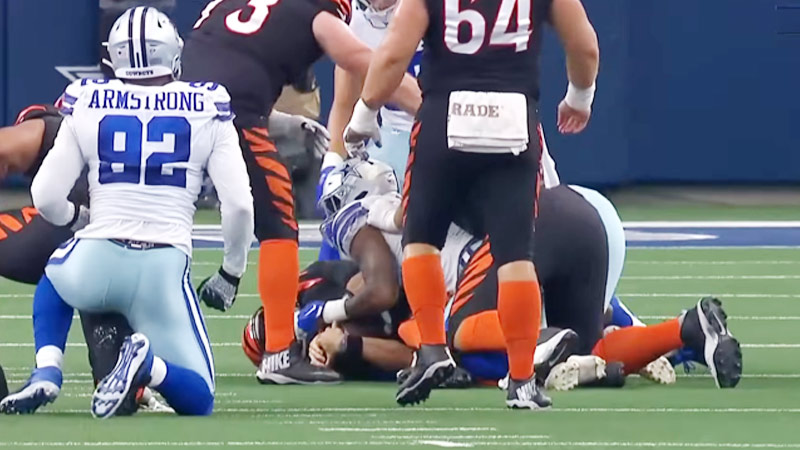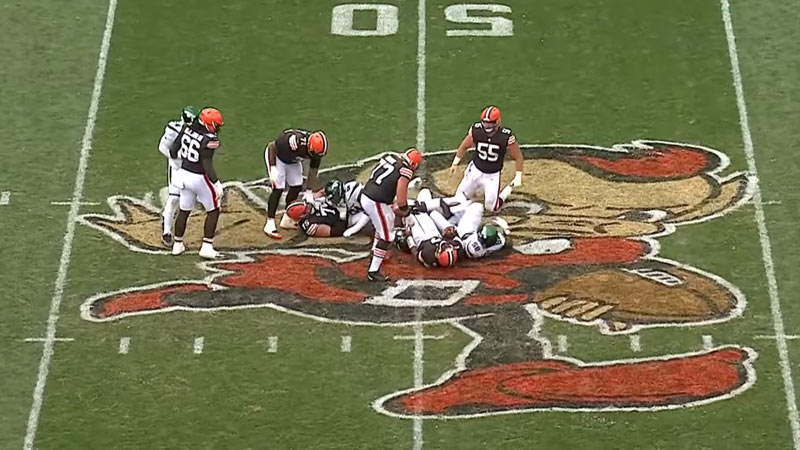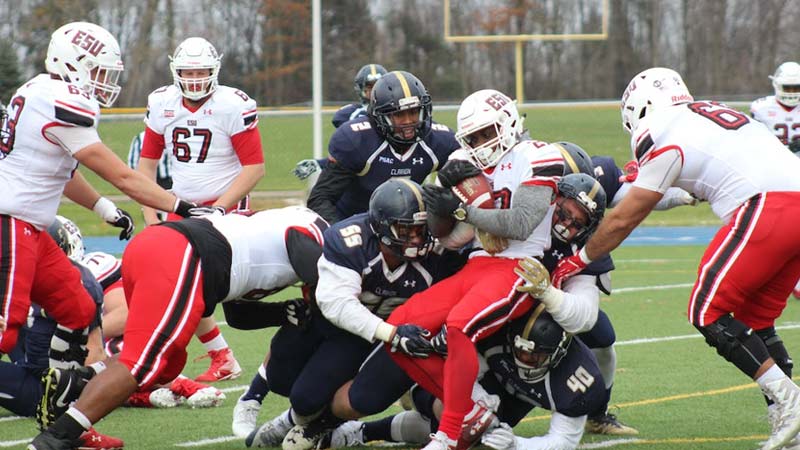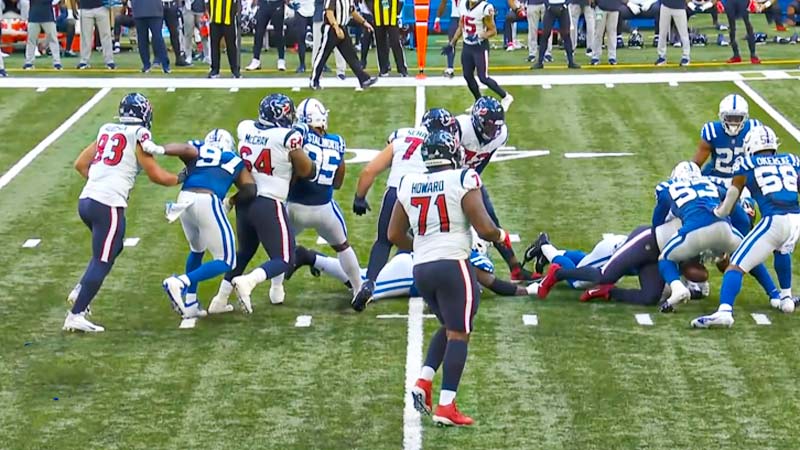Football is a sport that thrives on moments of intensity, strategy, and momentum shifts. Among the many dramatic turns that can occur during a game, the forced fumble stands out as a game-changing play that can turn the tide in an instant.
Whether you’re a seasoned football fan or new to the sport, understanding what a forced fumble is and its implications can enhance your appreciation for the intricacies of the game.
In this blog post, we’ll delve into the concept of a forced fumble, addressing common questions and shedding light on how this defensive maneuver impacts the course of football games. Stay focused.
What Is a Fumble in Football?
A fumble in gridiron football refers to a situation where a player who is in possession and control of the ball loses it unintentionally before they are downed (tackled), score, or step out of bounds.
According to the rules of the game, a fumble occurs when any action, apart from passing, kicking, punting, or successful handing of the ball, leads to the player losing possession of the ball.
In simpler terms, a fumble takes place when a player is carrying the ball, but due to contact with opposing players, a mishandling of the ball, or other factors, they drop it to the ground.
Once the ball is on the ground, it becomes a live ball, meaning that any player from either team can attempt to recover it. The team that recovers the fumble gains possession of the ball and gets the opportunity to continue their offensive drive.
Fumbles can have a significant impact on the game’s momentum and outcome, as they often lead to turnovers and sudden changes in possession.
What Is a Forced Fumble in Football?

A forced fumble in football occurs when a defensive player dislodges the ball from an offensive player’s possession, resulting in a fumble. This turnover can be caused by a solid hit, a deliberate strip of the ball, or any legal maneuver executed by a defensive player.
The primary objective is to disrupt the offensive team’s advance and gain possession of the ball for the defensive team.
Forced fumbles often require precise timing, technique, and physicality from the defensive player, making them pivotal game-changing plays that can shift momentum and provide valuable opportunities for the defensive team to regain control of the game.
What Is the Difference Between Fumble and Forced Fumble?
A fumble and a forced fumble are related concepts in football, both involving the loss of possession of the ball. However, they differ in terms of their origin and intent.
Fumble
A fumble occurs when a player who is in possession of the ball loses control of it, and the ball comes into contact with the ground or goes out of bounds.
This can happen for various reasons, such as a mishandled snap, a receiver dropping a pass, a ball carrier losing grip due to contact, or even a quarterback failing to secure the ball properly while being tackled.
Fumbles can result in turnovers, allowing the opposing team to gain possession of the ball. In essence, a fumble is an unintentional loss of possession caused by the ball carrier’s mistake or mishap.
Forced Fumble
A forced fumble, on the other hand, is a deliberate defensive play in which a defensive player intentionally dislodges the ball from an offensive player’s possession.
This can be achieved through well-timed hits, strip attempts, or legal maneuvers aimed at separating the ball from the ball carrier. The primary goal of a forced fumble is to create a turnover opportunity for the defensive team.
It requires a combination of technique, anticipation, and physicality. Unlike a regular fumble, a forced fumble is the result of a defensive player’s intentional action to disrupt the opponent’s possession and gain control of the ball.
So, the key distinction between a fumble and a forced fumble lies in their origin and intent.
A fumble is an accidental loss of possession caused by the ball carrier’s mistake, while a forced fumble is a purposeful defensive play aimed at creating a turnover by actively knocking the ball loose from the offensive player’s grasp.
How to Execute a Force Fumble?

Executing a forced fumble in football requires a combination of technique, timing, and physicality. Here’s a step-by-step guide on how to effectively execute a forced fumble:
Study the Opponent
Before the game, study the tendencies of the opposing team’s ball carriers. Identify their weaknesses, ball security issues, and preferred arms for holding the ball. This information can help you target vulnerable areas during the game.
Positioning
Position yourself correctly based on the situation. If you’re a defender, maintain a good angle to the ball carrier, aiming to attack from the side or slightly behind. This gives you a better chance to reach the ball without drawing a penalty for targeting.
Timing
Time your approach meticulously. Wait for the right moment, such as when the ball carrier is changing direction, shifting the ball to the other hand, or engaged in contact with another player. This split-second timing can make a significant difference in your success.
Technique
There are a few techniques you can employ to force a fumble:
Strip Technique
As you approach the ball carrier, focus on attacking the ball itself. Use your arm, hand, or even your helmet to swipe at the ball and attempt to knock it loose. Aim for the “pocket” between the arm and the body where the ball is likely to be less secure.
Rip Technique
If you’re coming from the side, you can use a “rip” motion with your arm to try and pull the ball out. This is effective when you can get your arm underneath the ball carrier’s arm.
Hit and Wrap
If you’re tackling the ball carrier, execute a solid hit while wrapping up the player. As you make contact, use your free hand to target the ball and attempt to dislodge it.
Use Leverage
Work on gaining leverage over the ball carrier. Lower your center of gravity and drive through your legs to generate power. This will help you exert force on the ball and potentially separate it from the ball carrier’s grasp.
Teamwork
Coordinate with your teammates to create additional opportunities for forced fumbles. A second defender can focus on securing the tackle while you go for the ball. Alternatively, a teammate can engage the ball carrier, making it easier for you to get a clean shot at the ball.
Practice
Force fumble drills in practice sessions can help you hone your technique and timing. Work on your strip and rip techniques, as well as your ability to read the situation and anticipate the right moment to attempt a forced fumble.
Stay Legal
It’s crucial to execute a forced fumble within the rules of the game. Avoid targeting the head or helmet of the ball carrier, as this can lead to penalties and potential injuries. Focus on hitting the ball while maintaining safe and legal play.
Remember, executing a forced fumble requires a balance of aggression and control. It’s a high-risk, high-reward play that can swing the momentum of a game, so practicing and refining your technique is essential to become effective at forcing turnovers.
What Are the Aftermaths of Force Fumble?

The aftermath of a forced fumble in football can have significant impacts on the game, the teams involved, and the overall momentum. Here are some of the key aftermaths of a forced fumble:
Turnover Possession
The immediate consequence of a successfully executed forced fumble is a change of possession. The defensive team gains control of the ball and becomes the new offensive team, which can be a game-changing shift.
Field Position
The location on the field where the forced fumble occurs determines the starting position for the offensive team that gains possession. If the fumble is forced deep into the opponent’s territory, the offensive team has a prime opportunity to score quickly.
Conversely, if the fumble is forced near the defensive team’s end zone, the offense may face a challenging task.
Momentum Swing
A forced fumble has the potential to shift the momentum of the game. The defensive team often gains a surge of energy and motivation, while the offensive team that lost the ball may experience a drop in morale.
This change in momentum can influence subsequent plays and the overall outcome of the game.
Field Position Battle
The ensuing offensive possession following a forced fumble can lead to a field position battle. If the defense can capitalize on the turnover and advance the ball significantly, it can put its own offense in a better position to score.
On the other hand, if the offense struggles to move the ball, the defensive team might gain an advantageous starting point for their next possession.
Scoring Opportunities
A forced fumble often presents immediate scoring opportunities for the defensive team.
They might find themselves in a favorable position to score a touchdown or, at the very least, attempt a field goal. Capitalizing on these opportunities can have a profound impact on the scoreboard.
Mental Impact
The psychological impact of a forced fumble extends beyond the field. The defensive team gains confidence and a sense of accomplishment, while the offense that lost the ball may need to regroup and refocus to overcome the setback.
Strategy Adjustment
The coaching staff of both teams will likely adjust their strategies based on the aftermath of a forced fumble.
The defensive team may choose to exploit the offensive team’s vulnerabilities that led to the fumble, while the offensive team may emphasize ball security and adjust their play-calling accordingly.
Fan Engagement
Forced fumbles are exciting and dynamic plays that engage fans. The sudden change of possession and the potential for a defensive score adds to the drama of the game, making it more thrilling for spectators.
FAQs
What is a forced fumble in football?
A forced fumble in football occurs when a defensive player deliberately knocks the ball loose from the possession of an offensive player, resulting in a fumble.
This play is characterized by the defensive player’s intentional effort to separate the ball from the ball carrier, often through hits, strips, or legal maneuvers.
How is a forced fumble different from a regular fumble?
While both involve a loss of possession, the key distinction lies in intent and execution. A regular fumble is accidental, typically caused by a mistake or mishap on the part of the ball carrier.
In contrast, a forced fumble is a calculated defensive move aimed at actively dislodging the ball from the offensive player’s grasp, requiring technique, timing, and physicality.
What are the outcomes of a successful forced fumble?
The aftermath of a forced fumble includes a change of possession, potentially leading to scoring opportunities for the defensive team.
It can swing the momentum of the game, impact field position, and prompt strategic adjustments by both teams. The psychological and fan engagement aspects also contribute to the lasting impact of this play.
What techniques are used to execute a forced fumble?
Defensive players can employ various techniques to execute a forced fumble. These include the strip technique (swiping at the ball), the rip technique (pulling the ball out), and combining hits with wrapping up the ball carrier.
Proper positioning, timing, and teamwork play crucial roles in successfully executing these techniques.
How does a forced fumble affect the flow of the game?
Beyond the immediate change of possession, a forced fumble can shift the momentum of the game, altering the psyche of both teams.
Coaches may adjust strategies based on the turnover, and fan engagement heightens as the potential for unexpected outcomes increases, showcasing the dynamic nature of football.
Wrapping Up
The forced fumble is more than just a defensive maneuver; it’s a strategic play that showcases the skill, anticipation, and physicality that define football.
As we’ve explored in this post, the deliberate effort to disrupt an opponent’s possession can lead to a cascade of effects, from scoring opportunities to momentum swings.
The nuances of a forced fumble enrich our understanding of the sport’s complexities and remind us of the game’s capacity for thrilling and unexpected turns.
So, the next time you witness a player successfully execute a forced fumble, you’ll have a deeper appreciation for the strategic brilliance behind this game-changing play. Best wishes.







